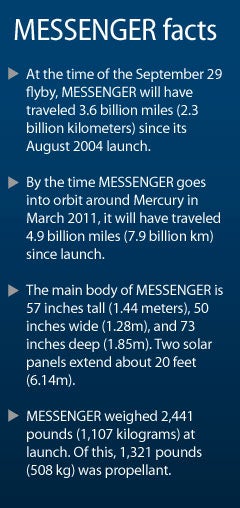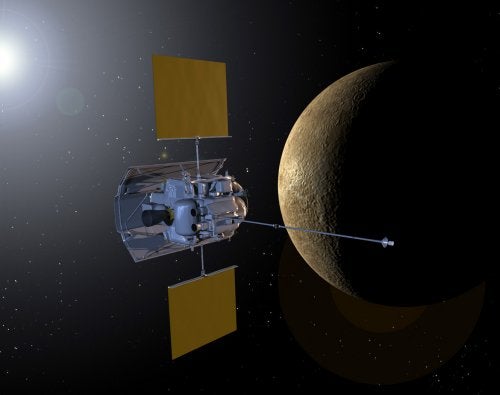

At 5:55 p.m. EDT September 29, NASA’s MESSENGER spacecraft will skim just 142 miles (228 kilometers) above Mercury’s surface.
NASA / JHUAPL / CIW

At 5:55 p.m. EDT September 29, NASA’s MESSENGER spacecraft will skim just 142 miles (228 kilometers) above Mercury’s surface. MESSENGER — short for MErcury Surface, Space ENvironment, GEochemistry, and Ranging — already has flown past Mercury twice. On January 14, 2008, the spacecraft viewed the innermost planet from as close as 124 miles (199 km). It passed equally close October 6, 2008.
During both previous flybys, MESSENGER imaged Mercury’s cratered surface and studied its puzzling magnetic field and thin atmosphere. On October 6, sunlight illuminated the hemisphere that lay in darkness January 14. For the upcoming encounter, the Sun will be beating down on nearly the same hemisphere as it did last October. So, what makes this flyby so exciting?
“MESSENGER will observe a thin strip of the inner planet that no one has ever seen up-close before,” says Astronomy magazine Senior Editor Michael E. Bakich. “The previous flybys revealed unexpected features, including a spider-like formation in the middle of the giant Caloris impact basin. Scientists hope more bizarre terrain may show up in this previously unexplored region.”
MESSENGER’s imaging system will take more than 1,500 photos of the planet’s surface during the next week. Scientists will combine approximately 200 of them into a high-resolution mosaic of Mercury’s southern hemisphere. The result will complement a northern hemisphere mosaic created from images taken last October. MESSENGER also will explore Mercury’s magnetic field and ultrathin atmosphere.
As exciting as these observations will be, they are not the flyby’s main purpose. “The key objective for MESSENGER during this flyby is to steal a little of the planet’s orbital energy,” says Talcott. “This will set it on a new course that will enable the spacecraft to orbit Mercury in 2011.”
When it returns to Mercury March 18, 2011, MESSENGER will fire its rocket and begin orbiting the planet. The spacecraft will follow a highly elliptical path that will bring it closest to the planet’s north pole. This primary mission is scheduled to last 1 Earth year, during which scientists will get a detailed look at Mercury’s global environment.









